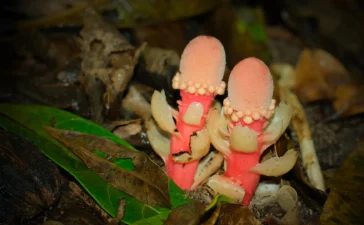Using syrup and baking soda, research at Niigata University has demonstrated the formation mechanism of rootless cones, small volcanic landforms commonly found on Earth and Mars. The study clarified, through an experimental approach, that a self-organization process determines the spatial distribution and size of these landforms. This research will enhance our understanding of explosive eruption phenomena caused by the interaction of lava and water and provide new insights into geological phenomena on the red planet.
Rootless cones are small volcanic landforms ranging from several to several hundred meters in diameter, formed by continuous explosions resulting from the interaction between surface lava and water bodies like lakes and rivers. Unlike regular volcanoes originating from magma rising from deep underground, rootless cones form when lava covers a water-containing layer, triggering explosive reactions. Due to this process, they are also called pseudocraters. While Iceland hosts many rootless cones, they are less common elsewhere, with small examples found along the Big Island’s coast in Hawaii. In contrast, vast fields of rootless cones have been identified on Mars, making their formation mechanisms a significant focus of planetary geology.
Associate Professor Rina Noguchi and her student Wataru Nakagawa of Niigata University conducted indoor analog experiments to simulate rootless cone formation. They used heated starch syrup as a lava analog and a mixture of baking soda and cake syrup to represent a water-containing layer.
In natural settings, lava temperatures exceed 1000°C, heating water until it vaporizes and expands explosively. However, starch syrup reaches only about 140°C before caramelizing, insufficient to vaporize water. To overcome this, the researchers used baking soda’s thermal decomposition — a reaction familiar from making karumeyaki (Japanese honeycomb toffee) — to enhance foaming. When heated by starch syrup, baking soda (sodium bicarbonate) releases carbon dioxide, intensifying foaming and simulating explosions akin to rootless cone formation. Cake syrup was added to adjust viscosity. The researchers varied the syrup thickness in a beaker and carefully analyzed the size and number of vents formed.
“We observed that conduits often failed to maintain their structure because they were disrupted by nearby forming conduits,” explained Assoc. Prof. Noguchi. The study revealed that conduit competition, in addition to water competition, significantly influences rootless cone spatial distribution. Thicker syrup layers showed more competition among conduits, increasing failed conduits, consistent with observations on Mars, where thicker lava correlates with fewer rootless cones. Conversely, in environments with abundant conduits (indicating many rootless cones), explosions were reduced due to limited water availability, leading to smaller cone edifices. This aligns with observations on Mars that show that areas with thin lava lack rootless cone-like features.
Further supporting this idea, failed conduit structures observed in terrestrial lava outcrops suggest that conduit competition universally affects rootless cone formation. These experiments and geological observations highlight that conduit merging and separation driven by lava thickness are key factors in determining the spatial distribution and size of rootless cones.
The findings contribute to a deeper understanding of rootless cone formation on Earth and advance knowledge about similar landforms on other planets, particularly Mars. Future research will integrate detailed field surveys with remote sensing data to refine formation models and improve interpretations of past environmental conditions linked to rootless cone development.
You Might Also Like
Eating more vitamin C can physically change your skin
Scientists at the University of Otago, Faculty of Medicine -- Christchurch Ōtautahi, have identified a direct connection between how much...
MIT scientists strip cancer of its sugar shield
A research team from MIT and Stanford University has developed a new technique designed to push the immune system to...
This “mushroom” is not a fungus, it’s a bizarre plant that breaks all the rules
In the damp shade beneath moss-covered trees, high in the mountains of Taiwan and mainland Japan or deep within the...
A quantum mystery that stumped scientists for decades is solved
A global research team led by Rice University physicist Pengcheng Dai has verified the presence of emergent photons and fractionalized...









